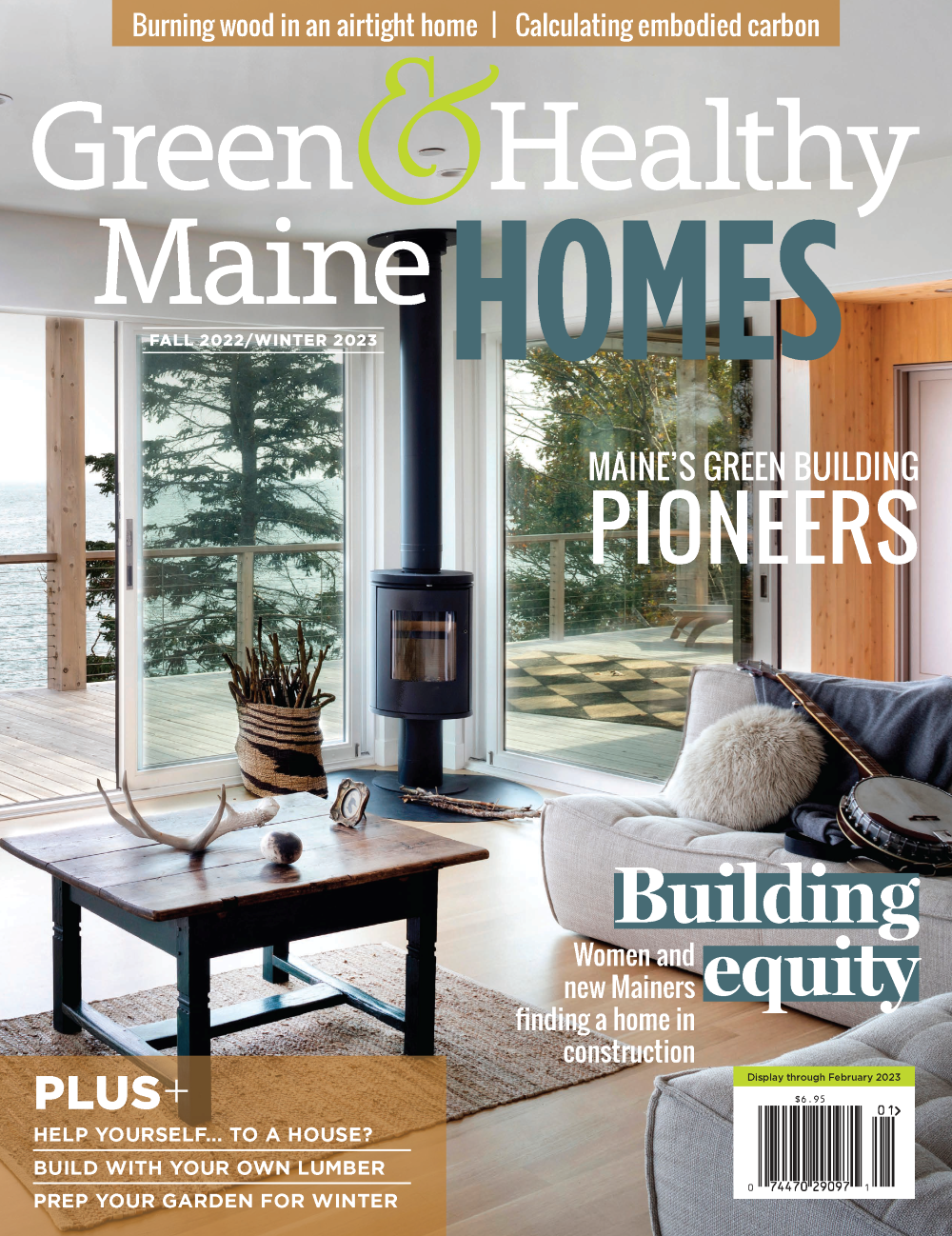Dale McCormick
Dale McCormick | Maine’s green building pioneers
Photo: Elyse Klysa
DALE MCCORMICK—carpenter, author, teacher, activist, politician and public servant—has achieved more firsts than most of us only dream of.
In 1975, after college, she became the first woman in the United States to complete a four-year apprenticeship with the International Brotherhood of Carpenters and Joiners and, she says, “in gender-neutral terms, achieve Journeyer level.” She next started a general contracting firm in Iowa specializing in solar and energy-efficient design, then left temporarily to take the Shelter Institute’s course in Maine, among the first in the country teaching smart, energy-efficient housebuilding. She moved to Maine in the early 1980s to teach carpentry at the owner-builder cooperative Cornerstones School in Brunswick. In the late ’80s, she launched the nonprofit Women Unlimited, a job training program in trade and technical occupations for women in underserved communities.
In 1990, McCormick was elected a state senator. In 1996, she was the first woman to be elected State Treasurer, holding that position for eight years. From 2005 to 2012, she served as director of MaineHousing, an independent state agency that finances affordable housing, weatherizes homes, and helps low-income Mainers buy their first home.
McCormick’s many honors include the Maryann Hartman Award for political leadership and for training women in nontraditional careers and the Crystal Vision Award from the National Association of Women in Construction. In 2007, McCormick was inducted into the Maine Women’s Hall of Fame. She is also the author of two books, Against the Grain: A Carpentry Manual for Women and Housemending: Home Repair for the Rest of Us.
Adam Krea, deputy director of MaineHousing, can speak directly to the remarkable impact McCormick has had on Maine—and beyond. “Dale initiated the very first green building and energy efficiency standards for MaineHousing-funded multi-family developments. She saw that energy-efficient housing was healthier for the inhabitants and served a greater public good by using less energy and creating fewer emissions.” And her work has had a strong ripple effect. Today, MaineHousing is a leader in advancing green building and energy efficiency standards.
Maine State Representative Barb Wood points to McCormick’s work for Maine women in trades-training as another great achievement. “Today most people don’t remember what it was like for women in the 1960s and ’70s to work in construction, as a woman in that field was almost unheard of. We always stand on the shoulders of those who came before us, and women would not be where they are now if it weren’t for the work Dale did back then.”
Note: the following interview has been edited for clarity and length.
Dale McCormick at the 1975 Iowa State Apprenticeship contest. Courtesy photo.
What do you think have been your greatest accomplishments?
In the first stages of my career, I’d say the small contracting company I created in 1975 in Iowa City, Iowa, McCormick Construction & Cabinetry; we were specialists in energy-efficient design. Then between 1978 and ’82, I created and taught the course “Housebuilding for Women” at Cornerstones. During this time, I realized that all the formulas and calculations the students needed to learn could be deadly boring, so in 1983 I wrote and illustrated a fun teaching tool I named Disco Kitty Does Heat Loss Calculation.
I’m also proud of founding Women Unlimited, a program to train low-income women in trade and technical jobs. Fast forward to around 2006, when I worked with developers to establish green building standards for all single and multifamily homes financed by MaineHousing. This was a great lesson in how powerful a collaborative effort can be in producing a product that has longevity.
Then in 2009, while I was Director of MaineHousing, my colleagues and I wrote and published a weatherization methodology under the Voluntary Carbon Standard to measure, monitor, and sell the tons of carbon not emitted after weatherizing a house to standards set by the National Weatherization Program, which is modeled on Maine’s early work and of which Maine is a part. The process was highly scientific and by the end, we were able to measure the percentage of energy that was saved via weatherization, which turned out to be 19%.
Courtesy photo
What gives you hope about the current environmental crisis in terms of the role that green building can play?
If you look at the way the European Union has decreased their carbon emissions since 1990, about 30%, more than Australia, Canada, the U.S., Japan, or other affluent countries, this means that others can do the same. I’ll bet those figures mean that the EU is pretty close to what is required of the individual countries and populations where they are not exacerbating the problem, even if they are not reversing it. Housing is an important part and a big percentage of carbon emissions, so green building standards and Passive House-type things can have that effect here, too.
What do you think is the biggest challenge in Maine in the housing sector today?
Affordable housing: Congress needs to allocate four times as many Section 8 housing vouchers as they do now, which allow families not to pay more than 30% of their budget on housing. The current amount of funding is woefully inadequate. This would go a long way towards solving our homeless problems.
How can we create more inclusive opportunities and environments in the building trades?
I’m a member of the National Taskforce on Tradeswomen's issues, which urged Congress to include in the National Infrastructure Bill best practices for recruiting and hiring women, Blacks, Indigenous and People of Color, so that all workers can compete for the millions of jobs created by the Infrastructure Act.
This article appeared in the Fall 2022 edition of Green & Healthy Maine HOMES. Subscribe today!
Find Maine experts that specialize in healthy, efficient homes in the Green Homes Business Directory.









